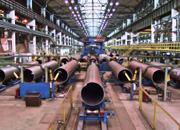The difference between 304 and 316 stainless steel pipes
Update:2023-11-27 View(s):924 Keywords :The difference between 304 and 316 stainless steel pipes
They are very similar in appearance. SS304%SS316 is an austenitic, non-magnetic, and non-heat hardening treatment.
1. Different element composition
SS304-→Chromium-18%, Nickel 8% SS316-→Chromium-16%, Nickel 10% and Molybdenum 2%
2. Different performance
The addition of molybdenum to SS316 helps to resist chlorides such as seawater. More suitable for coastal cities. SS304 is usually cheaper and is mainly used for kitchen utensils pots and storage tanks. SS316 has high corrosion resistance and can be used in oil refining equipment, pharmaceutical equipment, fasteners, bolts, etc.
3. Different maintenance methods
304 stainless steel: 18cr-8ni-0.08c has good corrosion resistance, oxidation resistance, and processability, strong oxygen acid resistance, can be punched, and can be used to make containers, tableware, metal furniture, architectural decoration, and medical appliances. 316 stainless steel: 18cr-12ni-2.5Mo is more common in seaside construction, ships, nuclear electrochemistry, food equipment, etc. It not only improves the corrosion resistance to chemical hydrochloric acid and the ocean but also improves the corrosion resistance to saltwater halogen solution.
4. Different grades
304 stainless steel grade is 0Cr18Ni9, while 316 stainless steel is 0Cr17Ni12Mo2
5. The difference in corrosion resistance.
Under normal circumstances, there is little difference between 304 stainless steel and 316 stainless steel in terms of chemical corrosion resistance, but they are different under certain specific media. Some of their relationships can be seen in the previously shared "Relationship between 304 and other stainless steel materials". When 304 stainless steel was first developed, under certain circumstances, this material was more sensitive to pitting corrosion. To reduce these sensitivities, an additional 2-3% molybdenum was added, resulting in 316 stainless steel. And this extra molybdenum can also reduce the corrosion of some hot organic acids. In various types of water (distilled water, drinking water, river water, boiler water, etc.), the corrosion resistance of 304 stainless steel and 316 stainless steel is almost the same, but when the content of chloride ions in the medium is very high, 316 stainless steel is more suitable. Specific analysis of specific circumstances.
6. Low-carbon type.
The corrosion resistance of austenitic stainless steel comes from the chromium oxide protective layer formed on the metal surface. When the temperature of the material is heated to 450 degrees-900 degrees, the structure changes, chromium carbide will be formed along the edge of the crystal instead of forming a chromium oxide protective layer, and the corrosion resistance will be reduced. This is also called "intergranular corrosion." As a result, there are 304L and 316L, both of which reduce intergranular corrosion due to their low carbon content. In particular, the higher intergranular corrosion sensitivity does not mean that non-low carbon content is more likely to be corroded. In a high-chlorine environment, this sensitivity is also higher.
 Threeway Steel is known as a professional supplier engaged in manufacturing and distributing a wide range of steel pipe, and our headquarter located the central part of China – Hunan and six associated factories throughout China.
Threeway Steel is known as a professional supplier engaged in manufacturing and distributing a wide range of steel pipe, and our headquarter located the central part of China – Hunan and six associated factories throughout China.
 Threeway Steel is known as a professional supplier engaged in designing, manufacturing and distribution of a wide range of steel products with the headquarter located the central part of China – Hunan and six associated factories throughout China.
Threeway Steel is known as a professional supplier engaged in designing, manufacturing and distribution of a wide range of steel products with the headquarter located the central part of China – Hunan and six associated factories throughout China.
 Threeway Steel is known as a professional supplier engaged in designing, manufacturing and distribution of a wide range of steel products with the headquarter located the central part of China – Hunan and six associated factories throughout China.
Threeway Steel is known as a professional supplier engaged in designing, manufacturing and distribution of a wide range of steel products with the headquarter located the central part of China – Hunan and six associated factories throughout China.
 Threeway Steel is known as a professional supplier engaged in designing, manufacturing and distribution of a wide range of steel products with the headquarter located the central part of China – Hunan and six associated factories throughout China.
Threeway Steel is known as a professional supplier engaged in designing, manufacturing and distribution of a wide range of steel products with the headquarter located the central part of China – Hunan and six associated factories throughout China.
 Threeway Steel is known as a professional supplier engaged in designing, manufacturing and distribution of a wide range of steel products with the headquarter located the central part of China – Hunan and six associated factories throughout China.
Threeway Steel is known as a professional supplier engaged in designing, manufacturing and distribution of a wide range of steel products with the headquarter located the central part of China – Hunan and six associated factories throughout China.

